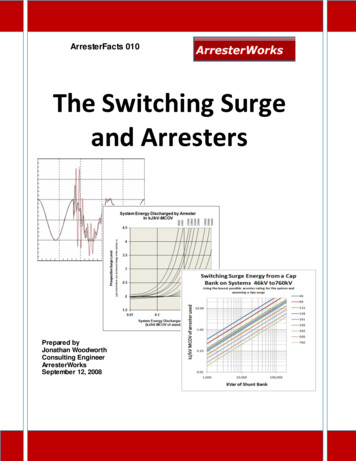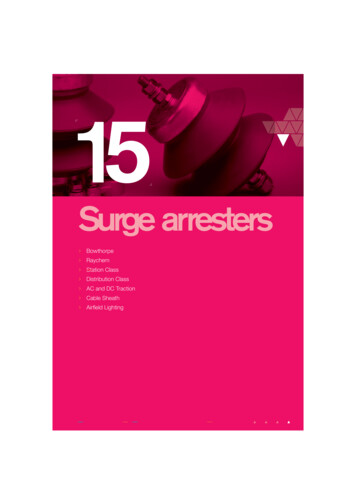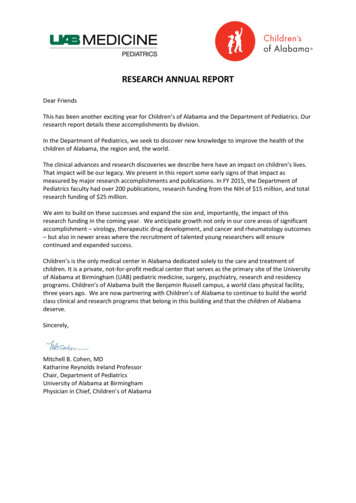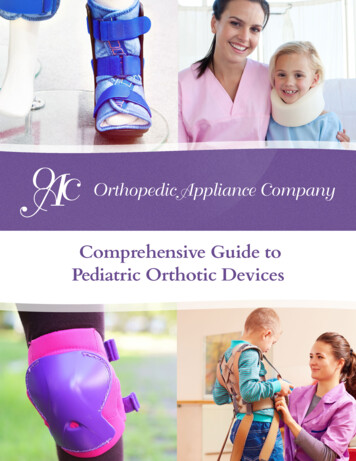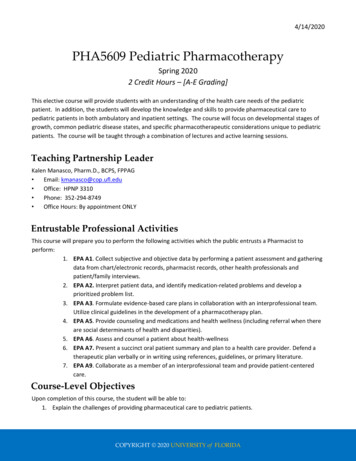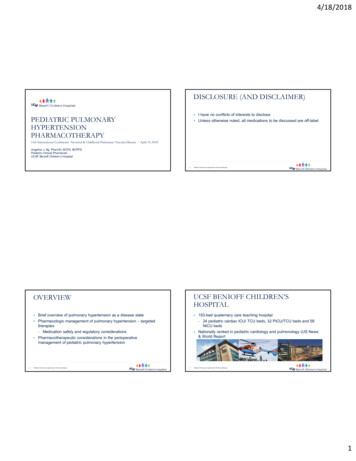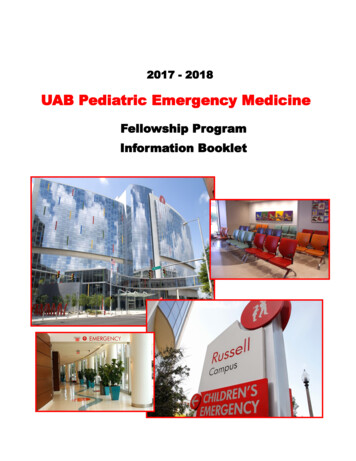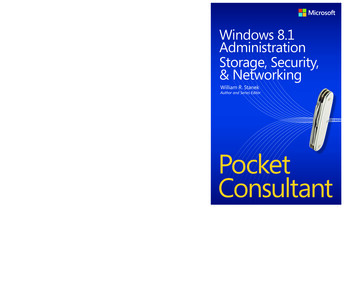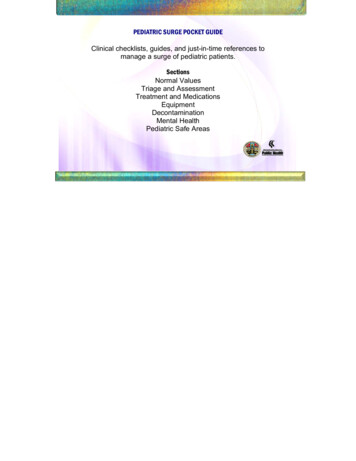
Transcription
PEDIATRIC SURGE POCKET GUIDEClinical checklists, guides, and just-in-time references tomanage a surge of pediatric patients.SectionsNormal ValuesTriage and AssessmentTreatment and MedicationsEquipmentDecontaminationMental HealthPediatric Safe Areas
PEDIATRIC SURGE POCKET GUIDEThis Pocket Guide was a collaborative effort by:Los Angeles County Department of Public HealthLos Angeles County Emergency Medical Services AgencyChildrens Hospital Los AngelesPediatric Liaison Nurses of Los Angeles CountyPediatric Disaster Resource CenterLong Beach Department of Health and Human ServicesPasadena Public Health DepartmentThis publication was supported by Grant Cooperative Agreement number5U90TP917012-08 from the U.S. Centers for Disease Control and Prevention (CDC).Its contents are solely the responsibility of the authorsand do not necessarily represent the official views of the CDC.June 2009
PEDIATRIC SURGE POCKET GUIDE: CONTENTSOverview: Pediatric Risks During Disasters. 1Section 1: Normal Values . 2Using Kilograms . 3Normal Pediatric Vital Signs. 4Normal Development . 5Daily Maintenance Fluid and Electrolyte Requirements . 6Normal Blood Volume . 7IV Administration Tips . 8Appropriate Infant Nutritional Components . 9Section 2: Triage and Assessment . 10Pediatric Assessment Triangle. 11JumpSTART Field Pediatric Multicasualty Triage System . 12Treatment Prioritization . 13Clinical Features of Dehydration . 14Wong-Baker FACES Pain Rating Scale . 15
FLACC Post-Operative Pain Scale . 16Glasgow Coma Scale. 17Burn Assessment: Pediatric Rule of Nines . 18Section 3: Treatment and Medications . 19Fluid Resuscitation. 24Hypovolemic Shock. 25AnalgesicsAcetaminophen, Ibuprofen, Morphine .26Fentanyl .28Dilaudid .30Lortab .32AntibioticsDoxycycline, Doxycycline for Anthrax icillin .40Cefazolin .42
Ceftriaxone .44Ciprofloxacin, Ciprofloxacin for Anthrax .46Cefotaxime .48AntipyreticsAcetaminophen, Ibuprofen .50AntiviralsSeasonal Flu .51H1N1 Influenza .52Asthma MedicationsAlbuterol .54Methylprednisolone, Prednisone.56Racemic Epinephrine .58Atrovent .60Xopenex (levalbuterol) .62Cardiac MedicationsAdenosine, Furosemide, Labetalol, Nifedipine.64
Infusion FormulasDopamine/Dobutamine, Epinephrine/Norepinephrine, Amiodarone, Lidocaine, Milrinone,Nitroprusside/Nicardipine, Terbutaline .66Neurology MedicationsLorazepam, Diazepam Rectal, Fosphenytoin, Phenobarbital, Mannitol 20% .67Paralyzing AgentsRocuronium, Succinylcholine, Vecuronium.69Resuscitation MedicationsAtropine, Amiodarone, Calcium Chloride 10%, Epinephrine 1:10,000,Epinephrine 1:1000 .70Glucose (D25W), Glucose (D10W), Lidocaine, Sodium bicarb 4.2%,Sodium bicarb 8.4 % .72Reversal AgentsFlumazenil, Naloxone.74Sedation MedicationsEtomidate, Fentanyl, Ketamine, Midazolam, Thiopental.75
Other MedicationsDiphtheria Tetanus.77Color Code Drug Doses by Weight3 kg, Color Code: Grey .784 kg, Color Code: Grey .795 kg, Color Code: Grey .806-7 kg, Color Code: Pink .818-9 kg, Color Code: Red .8210-11 kg, Color Code: Purple.8312-14 kg, Color Code: Yellow .8415-18 kg, Color Code: White.8519-22 kg, Color Code: Blue.8624-28 kg, Color Code: Orange .8730-36 kg, Color Code: Green .88Nerve Agent & Cyanide TreatmentOverview .890-2 months, Color Code: Grey - Avg Wt: 4 kg.903-6 months, Color Code: Pink - Avg Wt: 6.5 kg .917-10 mos, Color Code: Red - Avg Wt: 8.5 kg.9211-18 mos, Color Code: Purple - Avg Wt: 10.5 kg .93
1.5 - 3 yrs, Color Code: Yellow - Avg Wt: 13 kg.943 - 4 Years, Color Code: White - Avg Wt: 16.5 kg.955 - 6 Years, Color Code: Blue - Avg Wt: 20.5 kg.967 - 9 Years, Color Code: Orange - Avg Wt: 26 kg.9710 - 12 yrs, Color Code: Green - Avg Wt: 33 kg .98Burn Treatment: Fluid Resuscitation .99Section 4: Equipment .100Equipment Estimations .101Equipment Sizes .105C-Collar Size Information .104Section 5: Decontamination.105Decontamination Considerations .106Ambulatory Decon: Infants and Toddlers: Less than 2 years old .107Ambulatory Decon: Pre-School: 2 - 8 years old.108Ambulatory Decon: School Age: 8 - 18 years old .109Non-Ambulatory Decon: All Ages.110
Section 6: Mental Health.111Psychological First Aid: Objectives .112Psychological First Aid: Steps 1-5.113Psychological First Aid: Steps 6-9.114Mental Health Considerations .115Section 7: Pediatric Safe Areas .116Security Considerations .117Pediatric Safe Area Considerations: Location .118Pediatric Safe Area Considerations: Equipment and Supplies.119Pediatric Identification Considerations for Accompanied Children .120Resource Contacts .121References .122Notes Pages.124
OVERVIEW: PEDIATRIC RISKS DURING gicalRiskHigher breaths/minute increases exposure to inhaled agentsNuclear fallout and heavier gases settle lower to the ground andmay affect children more severely.May be more at risk for dehydration from vomiting and diarrheaafter exposure to contamination.Higher body surface area increases risk of skin exposure.Skin is thinner and more susceptible to injury from burns,chemicals and absorbable toxins.Increased risk of thyroid cancer from radiation exposure.Less able to cope with temperature problems with higher risk ofhypothermia.Less capability to escape environmental dangers or anticipatehazards.Prolonged stress from critical incidents.Susceptible to separation anxiety.1
SECTION 1: NORMAL VALUESContentsUsing Kilograms . 3Normal Pediatric Vital Signs. 4Normal Development . 5Daily Maintenance Fluid and Electrolyte Requirements . 6Normal Blood Volume . 7IV Administration Tips . 8Appropriate Infant Nutritional Components . 92
USING KILOGRAMSWeigh all children in kilograms.1kg 2.2 lbsExample: 20 lb child20 lb divided by 2.2 9 kgMethod to estimate weight: Newborn (term): usually 3 kg 1-10 yrs: age multiplied by 2 10 (kg) 10 yrs: age multiplied by 2 20 (kg)If available, a Broselow Tape may be used for weight estimation.3
NORMAL PEDIATRIC VITAL SIGNSNewborn0-1 monthInfant1-12 monthsToddler1-3 yearsPre-School Age3-5 yearsSchool Age5-11 yearsAdolescent13-18 yearsAdult18 yearsHRbeats/minRRbreaths/minBP (sys)mm/HgBP 2-20113-13665-844
NORMAL DEVELOPMENTAgeGross Motor SkillsFine Motor Skills2 monthsFlexed position when proneInhibited grasp reflex4 monthsRolls from front to back, back to sideCarries object to mouth6 monthsRolls from back to abdomenHolds bottle9 monthsSits steady, creeps or crawlsHolds objects in both hands andbangs together12 monthsCruises wellBangs 2 blocks together15-18 mosPushes and pulls toysUses cup well, some spoon agility2 yearsRuns well with wide stanceTurns doorknob and unscrews lids3 yearsClimbs stairs alternating feetCopies circles and cross4 yearsHops, jumps, and skips on one footDraws person with greater than 3body parts5 yearsSkips alternating feetPrints some letters5
DAILY MAINTENANCE FLUIDAND ELECTROLYTE REQUIREMENTSCalculationFluidsPer Hour4mL/kg/hr for first 10kg of weight2mL/kg/hr for next 10 kg of weight1mL/kg/hr for each kg over 20kgFluidsPer 24 HourPeriod100mL/kg for the first 10kg body weight1000mL 50mL/kg for the next 10kg body weight1500mL 20mL for each kg of body weight over 20kgMaintenanceElectrolyteCalculationsfor IV FluidSodium: 3-4 mEq/kg/day or 30-50 mEq/m2/dayPotassium: 2-3 mEq/kg/day or 20-40 mEq/m2/day6
NORMAL BLOOD VOLUMETotal blood volume varies by weight.Approximate volume is 80mL/kg.Examples:Newborn 3 kg x 80mL 240 mL5 year old 25 kg x 80mL 2000 mL (2L)13 year old 50 kg x 80mL 4000 mL (4L)PRBC/Platelet/Albumin 5%/FFP 10mL/kg7
IV ADMINISTRATION TIPSFor IV infusions in children, an over–the-needle 22 to 24 gauge cathetermay be used It may be possible to place a larger gauge catheter in olderchildrenCatheter should be secured with a transparent dressing and tapeUse of a padded armboard may be helpful to secure IV in young childrenIt is important to secure IV tubing to prevent infants and children frombecoming entangled or from accidently pulling catheter or needle outIf possible, amount of fluid hung that can be infused to patient should belimited to 2 hours of fluid with the use of buretrol or IV pump8
APPROPRIATE INFANT NUTRITIONAL COMPONENTSAgeBirth - 1 month2-3 ounces (6-90 mL) per feeding breast or bottle every 2-3 hours2-4 months3-4 ounces (90-120 mL) per feeding every 3-4 hours4-6 months4-5 ounces (120-150 mL) per feeding, four or more time dailyBegins baby food, usually rice cereal6-8 months6-8 ounces (180-240 mL) per feeding, four times dailyEats baby food such as rice cereal, fruits and vegetables8-10 months6 ounces (180 mL) per feeding, four times a daySoft finger foods10-12 months6-8 ounces (180-240mL) per feeding, four times a daySoft table foods, uses spoon and cup with lidFormulasMilk Based: Enfamil, Enfacare & SimilacSoy Based: Prosobee & Isomil9
SECTION 2: TRIAGE AND ASSESSMENT TOOLSContentsPediatric Assessment Triangle. 11JumpSTART Field Pediatric Multicasualty Triage System . 12Treatment Prioritization . 13Clinical Features of Dehydration . 14Wong-Baker FACES Pain Rating Scale . 15FLACC Post-Operative Pain Scale . 16Glasgow Coma Scale. 17Burn Assessment: Pediatric Rule of Nines . 1810
PEDIATRIC ASSESSMENT TRIANGLEAPPEARANCEMental statusMuscle toneBody ngCirculationSignsFocus on the child’s mental status and muscle toneDirect attention to respiratory rate and respiratory effortUse skin signs, color and capillary refill as indicators ofthe patient’s circulatory status11
JUMPSTART FIELD PEDIATRICMULTICASUALTY TRIAGE DIATEDECEASEDIMMEDIATEDELAYED12
TREATMENT PRIORITIZATIONTriage atients who do not obey commands,or do not have a peripheral pulse,or are in respiratory distress,or have uncontrolled major hemorrhageRemaining patients who do not fit the Red/Immediate orGreen/Minimal categoriesMinimalPatients with mild injuries that are self-limited and can tolerate adelay in care without increasing mortality riskBLACKExpectant: Patients who have injuries incompatible with lifegiven the currently available resourcesExpectant or DeadDead: Patients who are not breathing after life-savinginterventions13
CLINICAL FEATURES OF DEHYDRATIONFeatureMild ( 5%)Moderate (5% to 10%)Severe ( 10%)Heart rateNormalSlightly increasedRapid, weakSystolic BPNormalNormal to orthostatic, 10 mmHg changeHypotensionUrine outputDecreasedModerately decreasedMarked decrease, anuriaMucousmembranesSlightly dryVery dryParchedAnteriorfontanelNormalNormal to sunkenSunkenTearsPresentDecreased, eyes sunkenAbsent, eyes sunkenSkinNormal turgorDecreased turgorTentingNormal capillary refill( 2 seconds)Capillary refill slowed(2-4 seconds);skin cool to touchCapillary refill markedlydelayed ( 4 seconds);skin cool, mottled, graySkinperfusion14
WONG-BAKER FACES PAIN RATING SCALEInstructions:1. Point to each face using the words to describe the pain intensity.2. Ask the child to choose face that best describes own pain and recordthe appropriate number.Rating scale is recommended for persons age 3 years and older.15
FLACC POST-OPERATIVE PAIN SCALECategory012FaceNo particularexpression or smileOccasional grimace or frown,withdrawn, disinterestedFrequent to constantfrown, clenched jaws,quivering chinLegsNormal position orrelaxedUneasy, restless, tenseKicking or legs drawn upLying quietly, normalposition, moveseasilySquirming, shifting back andforth, tenseArched, rigid, or jerkingCryNo cry (awake orasleep)Moans, whimpers,occasional complaintCrying steadily, screamsor sobs, frequentcomplaintsConsolabilityContent, relaxedReassured by occasionaltouching, hugging or beingtalked to, distractibleDifficult to console orcomfortActivityFive categories (F) Face; (L) Legs; (A) Activity; (C) Cry; and (C) Consolability; is scoredfrom 0-2, which results in a total score between zero and ten.16
GLASGOW COMA SCALECategoryFor Patients 2 Years OldFor Patients 2 Years OldEye Opening(E)(4)(3)(2)(1)SpontaneousTo speechTo painNone(4)(3)(2)(1)SpontaneousTo speechTo painNoneVerbalResponse(V)(5)(4)(3)(2)(1)Coos, babblesIrritable, criesCries to painMoans to te (3)(2)(1)Normal spontaneous movementsWithdraws from touchWithdraws from painAbnormal flexionAbnormal extensionNone(6)(5)(4)(3)(2)(1)Obeys commandsLocalizes to painWithdrawal to painFlexion to painExtension to painNoneThe lowest possible score is 3 (deep coma or death).The highest is 15 (fully awake and aware)17
BURN ASSESSMENT: PEDIATRIC RULE OF NINESThe “Rule of Nines” is a convenient, quickmethod to determine burn size.Only second and third degree burn injury areused to calculate the extent of burn that is appliedto burn formula calculations.Alternate Method: The size of the patient’s hand,including the fingers, represents approximately1% of their body surface. This is useful to formapping irregular areas of burns.Pediatric Considerations Increased fluid requirements relative to adults Increased surface area : mass ratio Hypoglycemia may occur in infants ( 30 kg)due to limited glycogen reserves18
SECTION 3: TREATMENT AND MEDICATIONSContentsFluid Resuscitation.24Hypovolemic Shock.25AnalgesicsPart 1: Newborn - 6 Years: Acetaminophen, Ibuprofen, Morphine .26Part 1: 7 Years and Older: Acetaminophen, Ibuprofen, Morphine .27Part 2: Newborn - 6 Years: Fentanyl.28Part 2: 7 Years and Older: Fentanyl.29Part 3: Newborn - 6 Years: Dilaudid (Oral, IV, IM, SubQ).30Part 3: 7 Years and Older: Dilaudid (Oral, IV, IM, SubQ).31Part 4: Newborn - 6 Years: Lortab .32Part 4: 7 Years and Older: Lortab .33AntibioticsPart 1: Newborn - 6 Years: Doxycycline, Doxycycline for Anthrax.34Part 1: 7 Years and Older: Doxycycline, Doxycycline for Anthrax .35Part 2: Newborn - 6 Years: Clindamycin .36Part 2: 7 Years and Older: Clindamycin.37Part 3: Vancomycin .38Part 4: Metronidazole .39Part 5: Newborn - 6 Years: Amoxicillin.4019
Part 5: 7 Years and Older: Amoxicillin .41Part 6: Newborn - 6 Years: Cefazolin.42Part 6: 7 Years and Older: Cefazolin .43Part 7: Newborn - 6 Years: Ceftriaxone .44Part 7: 7 Years and Older: Ceftriaxone .45Part 8: Newborn - 6 Years: Ciprofloxacin, Ciprofloxacin for Anthrax .46Part 8: 7 Years and Older: Ciprofloxacin, Ciprofloxacin for Anthrax .47Part 9: Newborn - 6 Years: Cefotaxime .48Part 9: 7 Years and Older: Cefotaxime .49Antipyretics: Acetaminophen, Ibuprofen .50AntiviralsSeasonal Flu .51H1N1 Influenza: Less than 1 Year: Oseltamivir .52H1N1 Influenza: 1 Year and Older: Oseltamivir .53Asthma MedicationsPart 1: Newborn - 6 Years: Albuterol .54Part 1: 7 Years and Older: Albuterol .55Part 2: Newborn - 6 Years: Methylprednisolone, Prednisone .56Part 2: 7 Years and Older: Methylprednisolone, Prednisone .57Part 3: Newborn - 6 Years: Racemic Epinephrine .58Part 3: 7 Years and Older: Racemic Epinephrine .59Part 4: Newborn - 6 Years: Atrovent .6020
Part 4: 7 Years and Older: Atrovent .61Part 5: Newborn - 6 Years: Xopenex (levalbuterol).62Part 5: 7 Years and Older: Xopenex (levalbuterol) .63Cardiac MedicationsNewborn to 6 Years Old: Adenosine, Furosemide, Labetalol, Nifedipine .647 Years and Older: Adenosine, Furosemide, Labetalol, Nifedipine .65Infusion Formulas: Dopamine/Dobutamine, Epinephrine/Norepinephrine, Amiodarone,Lidocaine, Milrinone, Nitroprusside/Nicardipine, Terbutaline .66Neurology MedicationsNewborn to 6 Years: Lorezepam, Diazepam Rectal, Fosphenytoin, Phenobarbital, Mannitol20% .677 Years and Older: Lorezepam, Diazepam Rectal, Fosphenytoin, Phenobarbital, Mannitol20% .68Paralyzing Agents: Rocuronium, Succinylcholine, Vecuronium.69Resuscitation MedicationsPart 1: Newborn to 6 Yrs: Atropine, Amiodarone, Calcium Chloride 10%, Epinephrine1:10,000, Epinephrine 1:1000 .70Part 1: 7 Years and Older: Atropine, Amiodarone, Calcium Chloride 10%, Epinephrine1:10,000, Epinephrine 1:1000 .71Part 2: Newborn -6 Yrs: Glucose (D25W), Glucose (D10W), Lidocaine, Sodium bicarb21
4.2%, Sodium bicarb 8.4 %.72Part 2: 7 Years and Older: Glucose (D25W), Glucose (D10W), Lidocaine, Sodium bicarb4.2%, Sodium bicarb 8.4 %.73Reversal Agents: Flumazenil, Naloxone .74Sedation MedicationsNewborn to 6 Years Old: Etomidate, Fentanyl, Ketamine, Midazolam, Thiopental .757 Years and Older: Etomidate, Fentanyl, Ketamine, Midazolam, Thiopental.76Other Medications: Diphtheria Tetanus .77Color Code Drug Doses by Weight3 kg, Color Code: Grey .784 kg, Color Code: Grey .795 kg, Color Code: Grey .806-7 kg, Color Code: Pink .818-9 kg, Color Code: Red .8210-11 kg, Color Code: Purple.8312-14 kg, Color Code: Yellow .8415-18 kg, Color Code: White.8519-22
PEDIATRIC SURGE POCKET GUIDE Clinical checklists, guides, and just-in-time references to manage a surge of pediatric patients. Sections Normal Values Triage and Assessment Treatment and Medications Equipment Decontamination Mental

